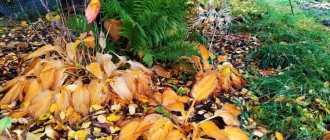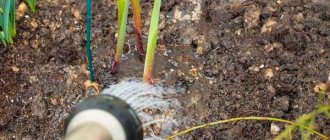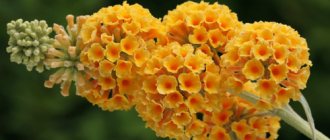Growing irises is not as difficult as it may seem to novice gardeners. Moreover, it will not be difficult to properly prepare irises for winter, of course, if you know all the nuances of caring for the plant after flowering. Actually, this is why you are reading these lines, trying to find the answer to one of the following questions about growing irises:
- Do I need to trim flower stalks after flowering, why and how to do it?
- Do I need to trim the leaves after flowering?
- When and how to prune irises in the fall?
- Do they need shelter and what kind?
The answers to all these questions regarding how to properly care for irises after flowering, as well as in the fall when preparing the bushes for winter, will be given below.
Caring for irises after flowering and in autumn - preparing flowers for winter
After flowering in summer and also in autumn, it is necessary to carry out the following measures to care for irises and prepare them for winter:
- summer and autumn pruning (breaking out flower stalks and trimming foliage);
- dividing and replanting (if necessary), as well as planting (for example, planting bulbous irises);
By the way! The site already has materials on how to plant and replant rhizomatous irises , as well as the nuances of planting and growing bulbous irises .
- shelter for the winter.
Note! Further in the article we will talk about what to do with rhizomatous irises (bearded and beardless) after flowering in summer and autumn, during preparation for wintering.
And also about bulbous irises ( Xyphium, Iridodictium and Juno) . Caring for them is somewhat different, so it is included in a separate paragraph at the end .
Planting or transplanting bulbs and rhizomes to another location
This plant can be replanted in early spring, but autumn replanting will ensure more abundant and lush flowering next season.
First of all, you should choose a convenient place for the irises. The most successful area will be one with good lighting and free access of air. It is unacceptable to select a place with strong drafts, since air currents will break flower stalks with large and heavy buds. It is also worth paying attention to the composition of the soil. Iris does not like stagnant moisture and soils with a high level of density, so you should choose a place on a small hill and ensure good drainage.
Pruning irises after flowering and in autumn
When irises begin to fade, many gardeners ask a completely logical question: “Is it necessary and how to properly prune irises after flowering?”
The short answer is yes, irises need pruning after flowering.
Trimming flower stalks after flowering
Firstly, you need to remove, or rather break off, all flower stalks in the optimal time frame (i.e. in a timely manner).
Another popular question: “ How long after flowering should the flower stalks of irises be broken off
Answer: As soon as all the flowers wither . If you have chosen the right time and the peduncle has fully matured, it will come off quite easily (it will break off with a bang). And if it bends and does not break, then it is too early (the peduncle has not matured).
If you do not do this on time, then seed pods will form, in other words, the plant will spend a lot of extra energy on reproduction.
- The most favorable moment (weather) for breaking out flower stalks is a windy, dry and sunny fine day . In such conditions, all wounds will dry out very quickly, become chapped and covered with a protective crust , which means that they will not be afraid of any rot.
The biggest danger is that the junction (attachment) of the peduncle and the iris tuber is very susceptible to rotting . In other words, if you do not carry out the operation to remove (break out) the flower stalks in a timely manner, the plant may rot.
- the flower stalks with pruning shears, but to break them out by hand.
Why is it better to use your hands rather than using garden tools?
The fact is that, using tools, you can easily transfer pathogens and various infections from infected to healthy plants.
Although it happens that many gardeners prune safely and everything is fine.
- The technology for manual breaking is as follows: you grab the lower part of the peduncle with your hand, with your thumb at the very root collar (the junction of the peduncle and the tuber), and then break it out with a sharp downward movement towards you.
- If, after breaking off the peduncle a kind of “boat” has formed , in other words, leaves remain , then so that moisture does not accumulate there and rotting processes do not suddenly begin, they (the leaves around the peduncle) should also be removed .
- After removing the flower stalks, the irises will be better ventilated and illuminated , and the growth divisions actively grow and strengthen .
Video: pruning irises after flowering
Do I need to trim the leaves immediately after flowering?
should under no circumstances be cut off after flowering .
The fact is that the root system of the plant must still recover after active flowering and stock up on nutrients before the onset of frost (and nutrition-photosynthesis occurs precisely through the leaves), accordingly, without it, growth divisions will also not be able to grow .
In any case, the foliage will remain decorative for a long time.
Another thing is that you should get rid of dry leaves , as well as leaves infected with fungal diseases (for example, leaves with spots). And then be sure to spray with one of the fungicides (a drug against diseases) so that the disease does not go further.
Pruning foliage in autumn before wintering
The foliage of irises is pruned closer to the second half of autumn, i.e. after it becomes withered. Then it is cut at a height of 10-15 cm, giving the leaves a cone shape so that water does not linger on them.
Only trim good foliage with a fan or cone; all dry foliage must be completely removed.
Advice! It is better to burn all cut foliage in order to destroy eggs of pests and pathogens potentially present in it (the same fungal spores).
Although, if there are no diseases, then you can send it to the compost heap.
Caring for rhizomatous irises in the open ground in autumn
Rhizomatous (or rhizomatous irises) are perennial rhizomatous plants. At the same time, rhizomatous irises are bearded and beardless. The plant is a representative of the Iris (Iridaceae) family. The plant also has other names: Cockerels, Iris. To keep them healthy and bloom beautifully in the open ground, you need to properly care for them in the fall.
Autumn pruning of irises
Pruning irises is the most important procedure for caring for a perennial plant. In this case, the procedure can be divided into two stages. The first pruning is done after flowering. And the second time you need to prune irises in the fall.
After flowering, the flower stalks must be removed. Flowers with ovules must be removed immediately. But after about 2 weeks, after the flowers have withered and the peduncle has matured (if broken, it should break easily with a crash), you need to remove the flower stem. In this case, a stump 2 cm long should remain from the stem. It is best to carry out the gardening activity on a dry, sunny and windy day.
It is impossible to trim the leaves immediately after flowering, because the process of photosynthesis continues throughout the summer.
However, if you see any specific leaves on the plant with signs of pests and diseases, then, of course, they need to be removed and burned immediately. And treat the plants with fungicides (against diseases) or insecticides (against pests).
But in the fall, full pruning of rhizomatous irises is carried out. When should you prune plants? The optimal timing of the care procedure should be chosen based on weather conditions and the condition of the plant itself. First, you need to prune 1-2 weeks before the first frost. Secondly, the procedure is carried out after the iris foliage becomes withered.
That is, approximately in the middle zone (Moscow region) pruning time occurs in the second half of October, in Siberia, the Urals, in the Leningrad region - in early October, in the South - in the second half of November.
The scheme for pruning irises is very simple: it is necessary to trim all the leaves at a height of 10-15 centimeters, while the remaining leaves should take on a cone shape (example in the photo below). Thanks to the cone shape, moisture will not be retained on the leaves, which can cause rotting. All dry leaves are completely removed.
There is also an important pruning rule: for the procedure you can only use sharp pruning shears that have been previously disinfected. In this case, you don’t have to worry about infecting the perennial with fungal infections.
Note! It is recommended to burn all cut plant debris immediately to eliminate possible pathogens or pests. Leaves should not be used as mulch, left in the garden, or placed in a compost pit.
Feeding irises in autumn
Proper feeding in the autumn will help achieve more lush and beautiful flowering of irises, and also helps them prepare for winter. But if the soil at your dacha is very poor, then ideally it is best to fertilize the perennial plant first 2-3 weeks after flowering, and then repeat in the autumn. In autumn, fertilizers should be applied in September, in the first half of October.
In autumn, plants need two elements: phosphorus and potassium, therefore, fertilizing should be done exclusively with potassium-phosphorus fertilizers. So, what to feed irises in the fall? For example:
- You can mix mineral phosphorus fertilizer - superphosphate (20-30 g per 1 square meter of flower bed) and potassium fertilizer - potassium sulfate (15 g per 1 sq.m.).
- Or you can use a ready-made complex mineral fertilizer - Potassium Monophosphate (10 g per 1 sq.m.). This option is better because the drug is absorbed faster.
- You can also use ready-made autumn fertilizer specifically for feeding this season. The packaging should say “For Autumn”, “Autumn”, etc. Use according to instructions.
- If you do not want to use mineral fertilizers, you can feed the irises with natural (organic) substances. For example, wood ash (a source of potassium) - 100 g per 1 sq.m., and bone meal (a source of phosphorus) in the same dosage.
It is important not only to choose the right fertilizers, but also to feed the irises correctly in the fall:
- It is most effective to pour in fertilizers in the form of a solution , thus the nutrients will penetrate to the roots faster and be absorbed faster. To do this, you need to dissolve the above amount of the substance in 10 liters of water and pour it under the plant. In this case, the mineral fertilizer granules must be completely dissolved in water (since superphosphate does not dissolve well, it must first be dissolved in boiling water).
- If dry fertilizing is more convenient for you, then simply lightly work the optimal amount of dry fertilizer into the soil, and then water it generously. By the way, this method of feeding is relevant during rainy autumn.
- The most important rule of any fertilizing: before applying any fertilizers, you need to water the soil in the open ground with plain water . Pre-watering will help avoid burning the roots.
- In autumn, you cannot feed irises and other crops with nitrogen fertilizers. Because nitrogen will provoke the growth of green mass, and this is completely unnecessary at this time (the plants will not be able to prepare for winter and will easily freeze).
Transplanting irises to a new place
Rhizomatous irises must be periodically replanted to a new location, usually once every 3-5 years. Otherwise, they will grow in one place, the center of the bush will become bare, and the flowers will begin to shrink.
The following instructions will help you replant the bush:
- Carefully dig up the bush, digging around it from all sides. Do not damage the rhizome. Now you should divide the bush into sections; if you can’t do it with your hands, you can use a knife. Each division should have 1-2 fused annual links and a fan of leaves.
- All rotten or dried roots are cut out, the rest of the normal ones need to be cut to 5 cm. And then the leaves are cut to 20 cm long (also in the shape of a cone).
- It is recommended to dip the rhizome in a light solution of potassium permanganate. And then it is advisable to leave the divisions outside for 1-2 hours before transplanting (unless the weather is dry). Before planting, you need to treat the cut areas with crushed charcoal.
- Plant the cuttings in the planting holes. The holes should be slightly larger than divisions, the distance between them is approximately 40 centimeters. In this case, the delenka needs to be planted in a hole on a mound made of a mixture of earth and sand. When planting, the upper part of the rhizome should be above the ground, and the bud should be at ground level. After this, the delenka is covered with earth.
By the way! This material describes in detail about planting and replanting rhizomatous irises.
Preparing irises for winter: mulching, shelter
Rhizomatous irises are quite frost-resistant flowers. Therefore, they do not need special shelter for the winter in the open ground (especially if the winter is snowy, because snow is the most reliable insulation). However, they need some preparation for winter.
When growing irises in any region (except the southern ones), it is recommended to mulch the flower garden. Mulching is carried out at the first frost (after feeding and pruning), that is, approximately in the middle, end of November. In this case, before mulching, it is necessary to loosen the soil between the rows, and you can also treat it with a fungicide to prevent fungal diseases.
Peat, humus, and compost can be used as mulch. The optimal layer thickness is 7-10 cm. It is important that the mulch lies loosely, not tightly.
If you live in regions with cold winters (Siberia, the Urals, Leningrad region), then it is advisable to cover the top of the mulch with spruce branches (put it on a frame made of planks). By the way, it is also important to fully cover the plants in the first year of life and after 4-5 years in one place (after all, at this age, without timely replanting, the roots begin to peek out of the soil).
Important! You can’t heavily cover and mulch irises for the winter, otherwise they will dry out!
Autumn feeding of irises
If you think that the potential of irises cannot be revealed because your soil is too poor, then 2-3 weeks after flowering or already in the fall you should fertilize them with phosphorus -potassium fertilizer (for example, superphosphate + potassium sulfate or just monophosphate).
By the way! If you are a supporter of organic farming, although this usually does not apply to fertilizing flowers and other ornamental plants, then you can take wood ash , bone meal, compost, and humus. Just don’t use fresh manure (only rotted manure).
Why prune irises in the fall?
Should irises be pruned in the fall for the winter? Rhizome irises need this procedure for a number of reasons:
- pests or their larvae can overwinter in drying foliage;
- even healthy-looking leaves can contain pathogens;
- covering varieties are much easier to prepare for winter;
- the amount of moisture on plants decreases, which protects them from rotting.
There are other cases when pruning is necessary:
- if the flower is replanted, which usually happens in August-September, the leaves must be cut into a cone or fan to balance the above-ground and underground parts with the disturbed roots (about 70% of the leaf height is cut off);
- when irises are pruned after flowering in the fall: in remontant varieties, the second wave of buds blooming in September, the dried flower stalks are pruned.
During the growing season, flower stalks need pruning (leaving a stump 2 cm long) and drying tips of leaves.
Advice ! If yellowing is caused by a disease, all damaged leaves must be removed, regardless of the stage of the growing season. They need to be burned.
All of the above applies to rhizomatous species; for bulbous species, all foliage is cut off approximately two weeks after flowering. The bulbs are dug up, dried and replanted in the fall.
Planting, dividing and replanting irises in autumn
The need for periodic replanting (dividing bushes) of irises is due to the fact that over time the plant grows to the sides, which is why the middle of the bush is exposed, and the flowers and shoots begin to become smaller.
In other words, iris bushes can grow in one place for up to 3-5 years, then they are divided and planted (replanted) in new places.
As a rule, dividing and replanting irises begins just after they bloom and break out the flower stalks, about 2-3 weeks later
Advice! The site already has articles on how to plant and replant rhizomatous irises , as well as the nuances of planting and growing bulbous irises .
Pruning will get rid of dried parts
In winter, the iris spends all its energy maintaining its vital activity.
The fewer dry leaves it has, the easier it is for the representative of the plant kingdom to survive the cold. As soon as flowering has completed, pruning is carried out. In the middle zone we are talking about the beginning of October, and in the southern regions - at the beginning of November. Regardless of the region, pruning is carried out 1.5 weeks before frost. Green leaves should not be touched. Photosynthesis is active in them. It is necessary to maintain the life of the plant. On a note! Dried parts, peduncles, stems and seed pods that are ripe must be removed.
Rules for pruning
Use pointed scissors. Accuracy is the key to success. Minor damage will lead to rotting and increased disease. The second rule is that you cannot pick dried leaves and flowers by hand. Other recommendations are as follows:
- peduncles are removed to the base;
- permissible stem length – 3 cm;
- stems longer than 3 cm are removed;
- in the first ten days of October, faded foliage is cut off at a level of 15 cm;
- The plant is given the shape of a cone.
After pruning is completed, irises are not watered or fertilized. The ban applies to organic nutrients - chicken droppings and manure.
Care after pruning
Botanists recommend using complex fertilizing 14 days before pruning and 2 weeks after its completion. They contain superphosphate and potassium salts. When choosing nutrients, the climatic features of the region are assessed:
- Mild winter - they rely on potassium and phosphorus. They increase the immunity of the iris. As flowering begins, buds form faster. For every 1 m2 of garden, take 30 g of potassium salt and 60 g of superphosphates. Before applying fertilizers, the flowers are watered and the soil is loosened.
- Severe winter - take any nutritional composition. Purchase it at a gardening supply store. For 1 bucket of water take 100 g of nutrient mixture. The solution is used for irrigation. Consumption level – ¼ bucket per 1 flower.
Botanists advise that you add a little less fertilizer than exceed the recommended dosage.
Sheltering irises for the winter
Irises overwinter very well simply under the snow, in almost any conditions, and never need shelter for the winter.
Opinion: “Northern Urals, winters down to -45 degrees. I never cover irises! The secret is that when planting, the top layer of soil is sprinkled with sand to a depth of 5 cm, but the backs of the irises are still on the surface. Everything will winter under the snow.”
However, if you have very severe frosts, then you can lightly (2-3 cm) cover with dry peat, humus, pine needles, leaves or agrofabric (spunbond), but in no case with film, otherwise they will dry out. Moreover, this must be done already in October-November, when stable frosts begin.
Worth understanding! In some sources you can find recommendations that irises should be mulched for the winter with a layer of as much as 8-10 cm, however, this does not make any sense: they are even more likely to be locked under your mulch than completely bare potatoes to freeze.
If it is worth covering irises for the winter, it is only to protect them from excess and stagnation of moisture in the early spring, when the snow begins to melt. In other words, irises are afraid of waterlogging and dampness, which is why they can simply rot.
covered with something , for example, roofing felt or slate, having first made a frame of boards or bricks.
Video: how and with what to cover irises for the winter
How and with what to cover irises for winter
Wild irises growing on the site should be subjected to all the measures listed above and left for the winter without shelter. The remaining varieties and species need shelter, which is appropriate to do with the onset of frost and the end of heavy rains. This is approximately the middle or second half of November, in more northern areas - depending on the climate. Premature covering is fraught with soaking and rotting of the root system of these plants. You can cover with improvised materials using peat, a 10-centimeter layer of which covers the rhizomes of irises. To insulate and preserve the air cushion, it is best to cover the top with spruce branches.
It is necessary to cover for the winter even frost-resistant varieties of annual irises even when the rhizomes reach the age of 4-5 years, which have already begun to protrude from the soil, because both the first and second can suffer during strong and protracted and, especially, little snow winters.
If your garden collection contains particularly delicate and frost-resistant irises, then you can preserve them in the same way as all bulbous garden flowers, whose bulbs overwinter outside the soil, for example, dahlias and gladioli. In dry weather, immediately after the leaves dry, they should be dug up, trimmed, treated with insecticides and, if necessary, fungicides and, after drying in the open air for a month at a temperature of about +25 C, stored until spring planting in open ground in a cool, dry room. .
The shelter you have built, taking into account the early biological awakening of irises, can be removed immediately after the snow melts. You should not be afraid of slight return frosts - irises are adapted to changes in spring temperatures and will normally begin to actively grow.
If it turns out that the irises did suffer during the harsh wintering period, then they need to be treated according to indications: clean the upper part of the frozen rhizome to hard tissue. Thoroughly treat the resulting wounds with a rich, wine-colored aqueous solution of potassium permanganate and sprinkle crushed black activated carbon or organic ash on top. All these timely measures will allow you to defeat the rotting process that has begun and the iris to develop in all its glory.
The recommendations for growing irises listed in this article have been tested by the extensive experience of many gardeners and serve only as advice for you, the task of applying which you will, of course, decide on your own. We can say with confidence that you will not regret it - you will be rewarded with a lush, long-lasting flowering of any variety of iris that is unusually beautiful and mysterious in its structure. Good luck and be bold!
Why is pruning necessary?
To answer the question of whether it is necessary to prune irises for the winter, you should familiarize yourself with the need for this procedure. Autumn pruning of the above-ground parts of plants is required for the following reasons:
- Due to the rotting of wilted leaves, the root system may collapse, and therefore the plant dies.
- Fungal spores remaining under the snow infect young shoots.
- The above-ground part will interfere with the treatment of the soil with fungicides, mulching the soil and covering plants.
- Withered leaves and stems are considered a wintering site for polyphagous pests.
- Spring pruning can damage the growth buds.
- The root system must accumulate strength for spring.
- Saves time for spring work.
- The flower beds will look aesthetically pleasing.
Typically, all perennial plants are pruned. These include hosta, hellebore, sedum, bergenia, and periwinkle. Some insulate using spruce spruce branches or frame shelters.
Shelter
Wintering of plants must be successful, therefore, when preparing plants, it is necessary to take into account the climate of the region and the type of winter. But often climatic conditions are unpredictable. Because of this, it is advisable to plant tender varieties in the southern regions.
For the middle zone, the Volga region, the Urals, and Siberia, it is necessary to choose frost-resistant plant hybrids that have been tested for frost resistance in a certain area. It is advisable to purchase seedlings grown by Russian breeders.
In the southern territories, irises do not need to be covered. And in cold regions, you should know which types of plants require this procedure, since not everyone needs it.
Prevention of diseases and pests
Irises are not without the attention of many garden pests, and diseases are a common problem for gardeners, so in order to increase your chances of successfully growing these flowers, it is worth knowing about some preventive measures:
- to prevent the invasion of slugs, which become active in early summer, it is recommended to treat the soil around the rosettes with superphosphate, simply scattering it under the iris bushes;
- timely cutting of the affected parts and treating the cutting sites with a concentrated solution of potassium permanganate will help prevent the spread of root rot;
- if, having decided to thin out the crop, you notice leaves covered with rusty or dark spots, you should burn them immediately, and spray the remaining plant with a solution of Bordeaux mixture - for preventive purposes, a one-percent composition is sufficient, while to treat a crop, a three-percent mixture will be required;
- if gray areas with a wet edge appear on the leaves, the development of heterosporiosis can be suspected, and fungicidal preparations containing copper and zinc will help get rid of it (the dosage and rules for using such substances are always indicated on the packaging);
- To protect iris plantings from aphids, thrips, wireworms and fall armyworms, any systemic insecticides (for example, Confidor Maxi) would be appropriate, and treatment with them should be carried out several times a season (when using half the dosage indicated on the package, you can spray the flowers to prevention, especially if pests have already been noticed in a particular area).
Other preventive measures include regular inspection and treatment of plants with a fungicide solution, especially with high humidity in summer and autumn (at least once every 10–14 days). If possible, it is worth adding insecticidal preparations to the finished working composition that can increase the resistance of plants to pests.
Important! It is better to use chemical compounds in the early morning or in the evening when the air temperature is above +20°C.
When deciding whether to trim your irises completely or just trim off the faded flower stems, always consider the variety of your flower. It is likely that it is enough to only trim the plant occasionally, in particular before wintering or immediately after flowering, to ensure the preservation of its decorative appearance.
Frost resistance of irises
The most winter-hardy varieties are considered to be Russian varieties, as well as foreign ones that have been tested by time. Tall plants are vulnerable. Most of them have good protection from frost with a snow thickness of 30 cm.
In the Moscow region, dwarf and medium-sized irises overwinter without shelter. It is not winter frosts that are harmful to them, but spring frosts, since there is a possibility of death of young buds. Do I need to prune the leaves of non-frost-resistant iris varieties in harsh climates for the winter? Preserving plants requires digging them up, like gladioli. In spring, the bulbs are planted in soil warmed to 10 degrees.
Do I need to cut irises for the winter? Basic rules for plant care
First of all, it is worth saying that the rhizome of this flower requires minimal care.
After planting the iris, you just need to manually remove the weeds and carefully loosen the soil. It must be taken into account that the rhizome of the plant is quite close to the soil surface. When the flowers grow quite strongly, it is recommended to eliminate weeding and loosening altogether. There are several recommendations that should be followed when growing iris. First, you need to water the plant daily in dry weather. If the summer turns out to be normal, then it is enough to moisten the soil 3 times a week. It is recommended to water the plants in the evening. In this case, you need to ensure that drops of moisture do not fall on the leaves of the flower.
It is recommended to tie plant stems that are too weak to supports. If a bulbous type of iris grows on the site, then it is necessary to promptly remove wilted or old leaves.
Fertilizers are applied 3 times per season: in the spring, at the time of budding and within 30 days after flowering. Spring feeding is carried out using fertilizers, which contain a high content of potassium, nitrogen and phosphorus. During the budding process, the same fertilizer is used, but in larger quantities. When the iris has bloomed, it is recommended to apply phosphorus and potassium fertilizers. It is very important not to feed the plants during the flowering period. It is also necessary to prune irises. It is worth considering that these activities are performed more than once. Let's take a closer look.
Principles of care
Do I need to prune irises for the winter to prepare the plants for the cold season? This procedure is mandatory. Also required to prepare for winter:
- feeding;
- transplantation (if required);
- shelter.
Each procedure has its own characteristics. It is important to follow all the details to protect and preserve your plants.











